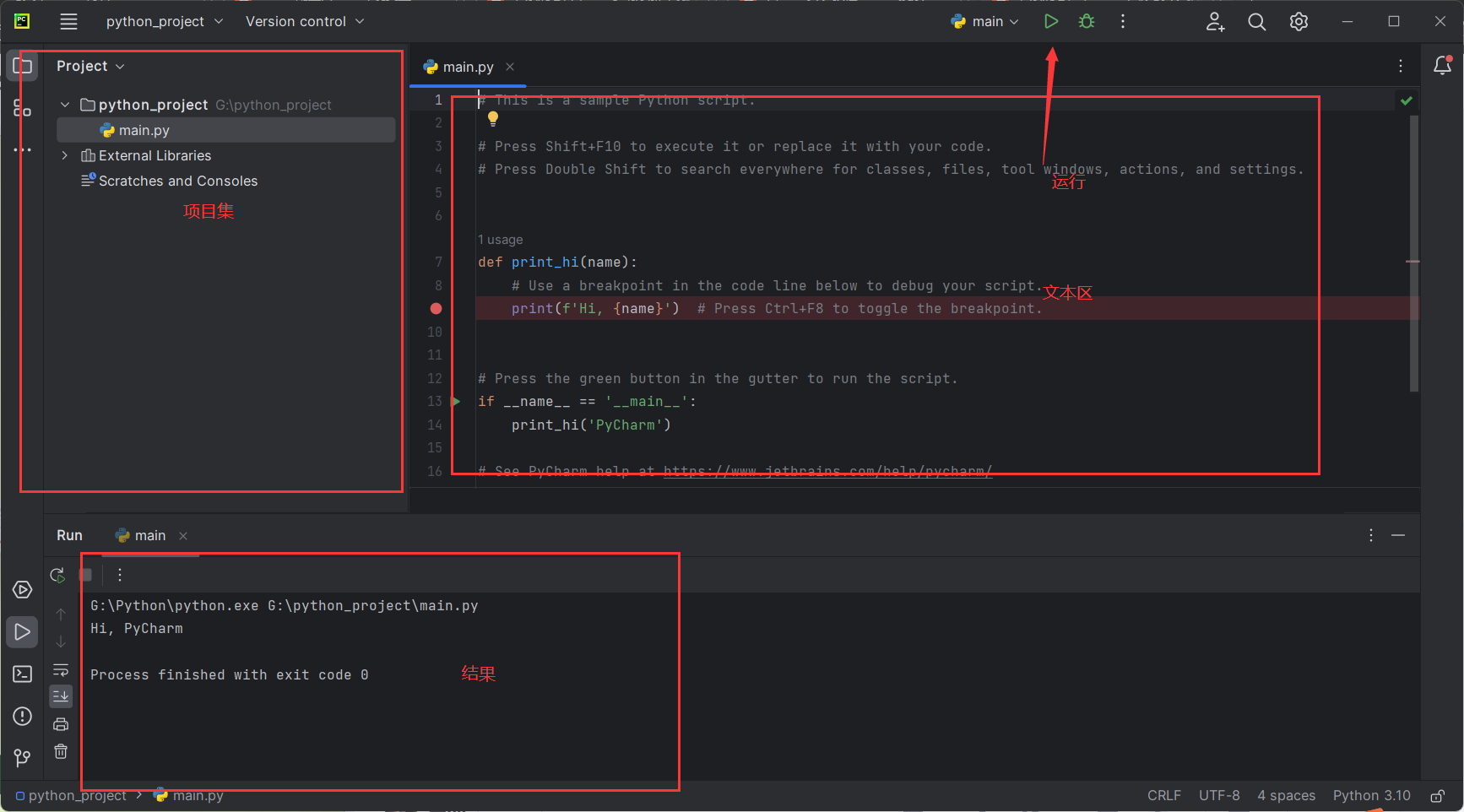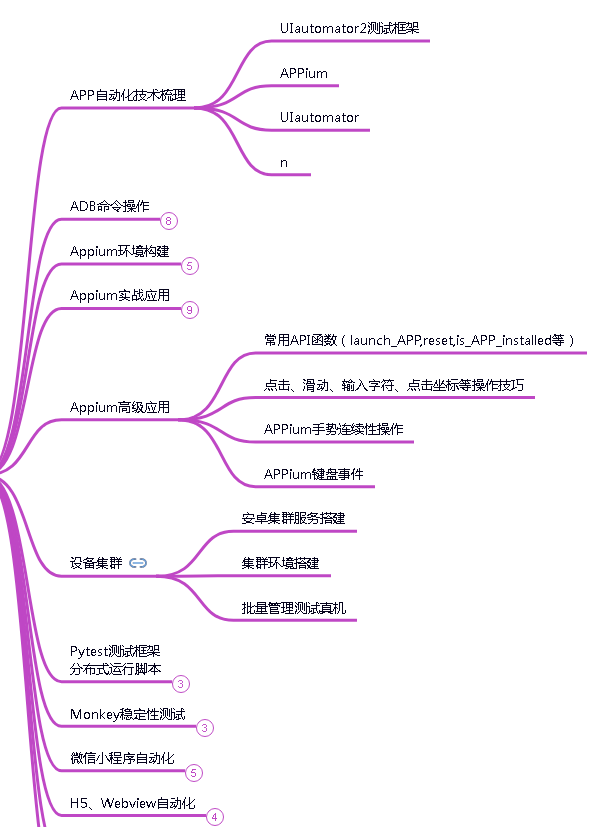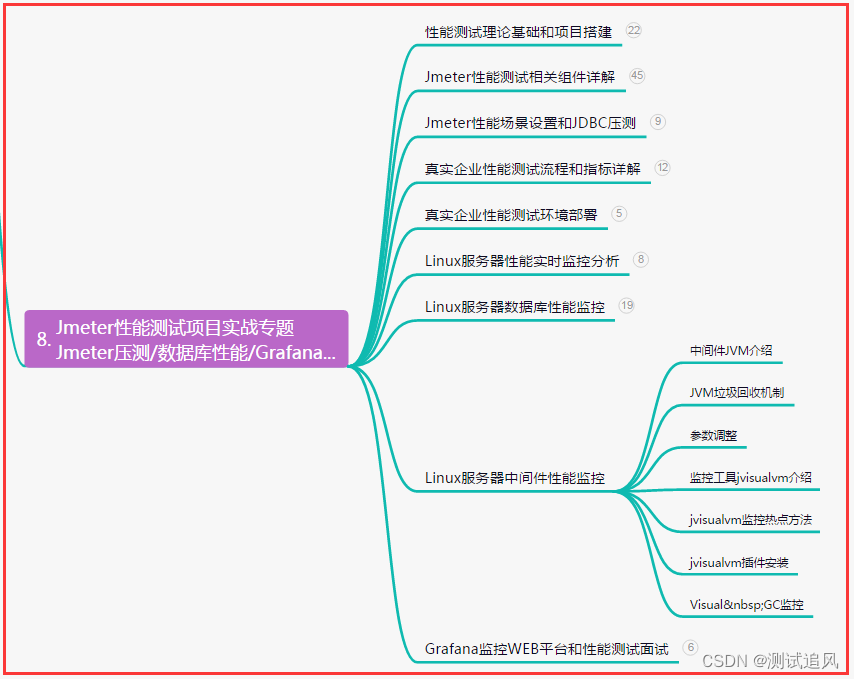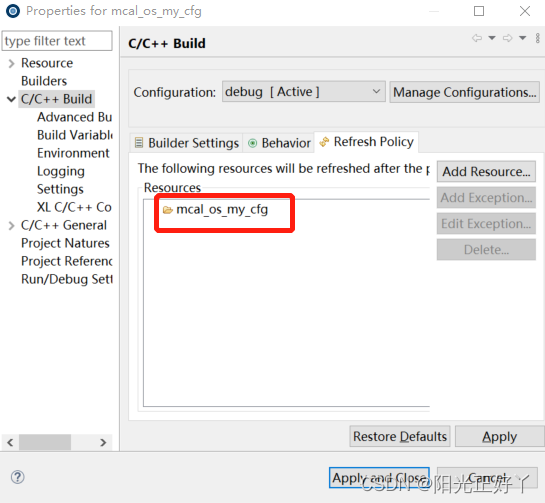Nest 附带一个默认的内部日志记录器实现,它在实例化过程中以及在一些不同的情况下使用,比如发生异常等等(例如系统记录)。这由 @nestjs/common 包中的 Logger 类实现。你可以全面控制如下的日志系统的行为:
- 完全禁用日志
- 指定日志系统详细水平(例如,展示错误,警告,调试信息等)
- 覆盖默认日志记录器的时间戳(例如使用 ISO8601 标准作为日期格式)
- 完全覆盖默认日志记录器
- 通过扩展自定义默认日志记录器
- 使用依赖注入来简化编写和测试你的应用
- 你也可以使用内置日志记录器,或者创建你自己的应用来记录你自己应用水平的事件和消息。
更多高级的日志功能,可以使用任何 Node.js 日志包,比如Winston,来生成一个完全自定义的生产环境水平的日志系统。
重点目录
- 常见日志及获取(记录)方式
- 第三方日志方案:winston(勤快的人)、pino(推荐懒人)
- 通用业务系统日志系统配置(学习定时任务)
日志等级
- Log : 通用日志,按需进行记录(打印)
- Warning:警告日志,比如: 尝试多次进行数据库操作
- Error:产重日志,比如:数据库异常
- Debug: 调试日志,比如:加载数据日志
- Verbose:详细日志,所有的操作与详细信息(非必要不打印)
功能分类日子
- 错误日志->方便定位问题,给用户友好的提示
- 调试日志->方便开发
- 请求日志->记录敏感行为
日志记录位置
- 控制台日志->方便监看(调试用)
- 文件日志->方便回溯与追踪(24小时滚动)
- 数据库日志->敏感操作、敏感数据记录
Nestjs 中记录日志
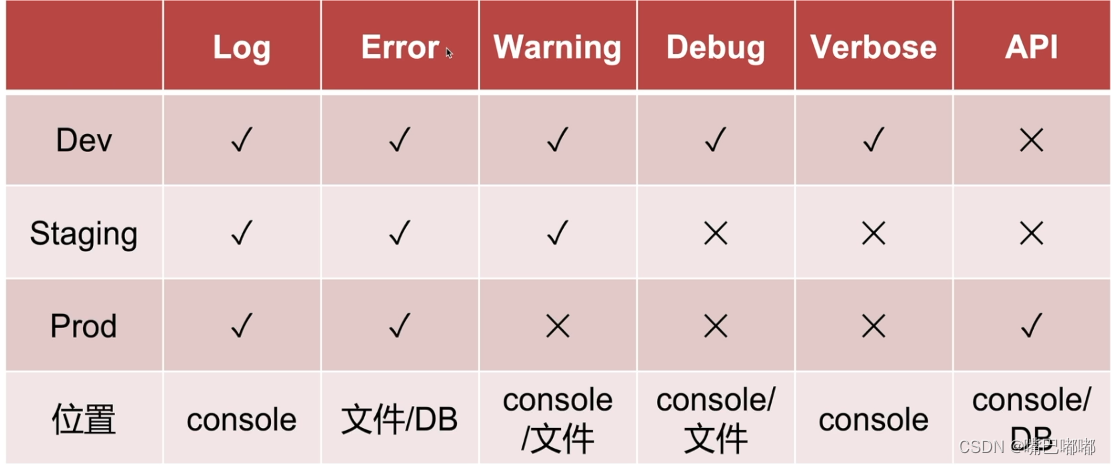
接下来我们实操一下日志功能。
基础自定义
要禁用日志,在(可选的)Nest 应用选项对象中向 NestFactory.create() 传递第二个参数设置 logger 属性为 false 。
app.module.ts
const app = await NestFactory.create(ApplicationModule, {
logger: false,
});
await app.listen(3000);
根据级别显示
// 层次类型
export type LogLevel = 'log' | 'error' | 'warn' | 'debug' | 'verbose';
// 创建app时使用配置 logger 层次
const app = await NestFactory.create(ApplicationModule, {
logger: ['error', 'warn'],
});
await app.listen(3000);
自定Logger
Pino、日志滚动pino-roll
git地址
安装
pnpm install nestjs-pino
使用
user.module.ts注册
import { Module } from '@nestjs/common';
import { UserController } from './user.controller';
import { UserService } from './user.service';
import { TypeOrmModule } from '@nestjs/typeorm';
import { User } from './user.entity';
import { Logs } from '../logs/logs.entity';
import { LoggerModule } from 'nestjs-pino';
@Module({
imports: [TypeOrmModule.forFeature([User, Logs]), LoggerModule.forRoot()],
controllers: [UserController],
providers: [UserService],
})
export class UserModule {}
user.controller.ts中使用
import { Controller, Delete, Get, Patch, Post } from '@nestjs/common';
import { UserService } from './user.service';
import { ConfigService } from '@nestjs/config';
import { User } from './user.entity';
import { Logger } from 'nestjs-pino';
@Controller('user')
export class UserController {
// private logger = new Logger(UserController.name);
constructor(
private userService: UserService,
private configService: ConfigService,
private logger: Logger,
) {
this.logger.log('UserController init');
}
@Get()
getUsers(): any {
// this.logger.log(`请求getUsers成功`);
return this.userService.findAll();
// return this.userService.getUsers();
}
}
结果


注意 因为pino是懒人必备,所以默认打印出来的样式比较丑,那么我们还需要另外一个插件pnpm i pino-pretty 。安装完毕我们需要在app.modules.ts 做如下配置
import { Module } from '@nestjs/common';
import { UserController } from './user.controller';
import { UserService } from './user.service';
import { TypeOrmModule } from '@nestjs/typeorm';
import { User } from './user.entity';
import { Logs } from '../logs/logs.entity';
import { LoggerModule } from 'nestjs-pino';
@Module({
imports: [
TypeOrmModule.forFeature([User, Logs]),
LoggerModule.forRoot({
pinoHttp: {
transport: {
target: 'pino-pretty',
options: {
colorize: true,
},
},
},
}),
],
controllers: [UserController],
providers: [UserService],
})
export class UserModule {}
重启项目 日志如下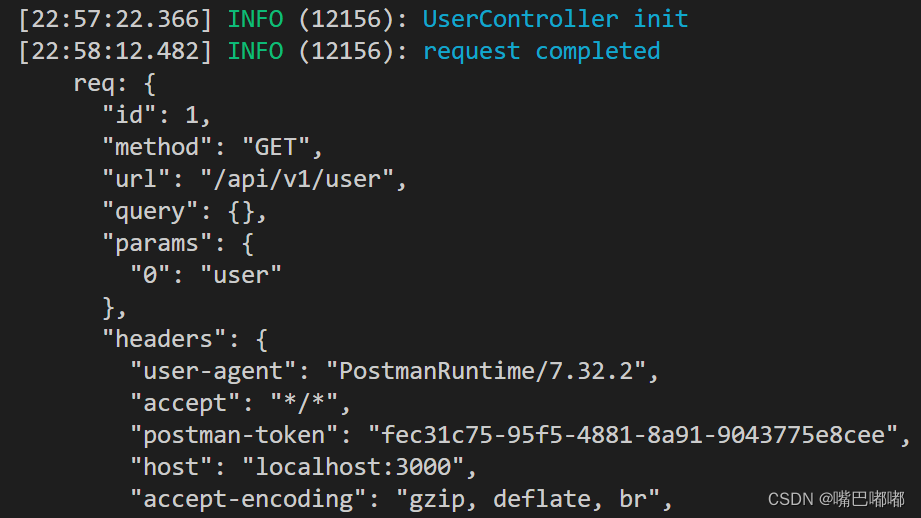
注意 代码我们还需要改一下,因为我们在生产环境是不需要这样打印。
import { Module } from '@nestjs/common';
import { UserController } from './user.controller';
import { UserService } from './user.service';
import { TypeOrmModule } from '@nestjs/typeorm';
import { User } from './user.entity';
import { Logs } from '../logs/logs.entity';
import { LoggerModule } from 'nestjs-pino';
@Module({
imports: [
TypeOrmModule.forFeature([User, Logs]),
LoggerModule.forRoot({
pinoHttp: {
transport:
process.env.NODE_ENV === 'development'
? {
target: 'pino-pretty',
options: {
colorize: true,
},
}
: {
target: 'pino-roll',
options: {
file: 'log.txt',
// 周期
frequency: 'daily',
mkdir: true,
},
},
},
}),
],
controllers: [UserController],
providers: [UserService],
})
export class UserModule {}
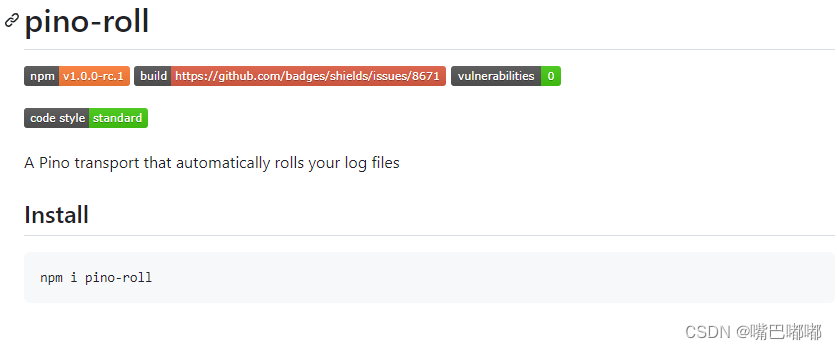
当然为了测试方便 我们可以这样写:
import { Module } from '@nestjs/common';
import { UserController } from './user.controller';
import { UserService } from './user.service';
import { TypeOrmModule } from '@nestjs/typeorm';
import { User } from './user.entity';
import { Logs } from '../logs/logs.entity';
import { LoggerModule } from 'nestjs-pino';
import { join } from 'path';
@Module({
imports: [
TypeOrmModule.forFeature([User, Logs]),
LoggerModule.forRoot({
pinoHttp: {
transport: {
targets: [
{
level: 'info',
target: 'pino-pretty',
options: {
colorize: true,
},
},
{
level: 'info',
target: 'pino-roll',
options: {
file: join('logs', 'log.txt'),
frequency: 'daily',
mkdir: true,
},
},
],
},
},
// pinoHttp: {
// transport:
// process.env.NODE_ENV === 'development'
// ? {
// target: 'pino-pretty',
// options: {
// colorize: true,
// },
// }
// : {
// target: 'pino-roll',
// options: {
// file: 'log.txt',
// // 周期
// frequency: 'daily',
// mkdir: true,
// },
// },
// },
}),
],
controllers: [UserController],
providers: [UserService],
})
export class UserModule {}
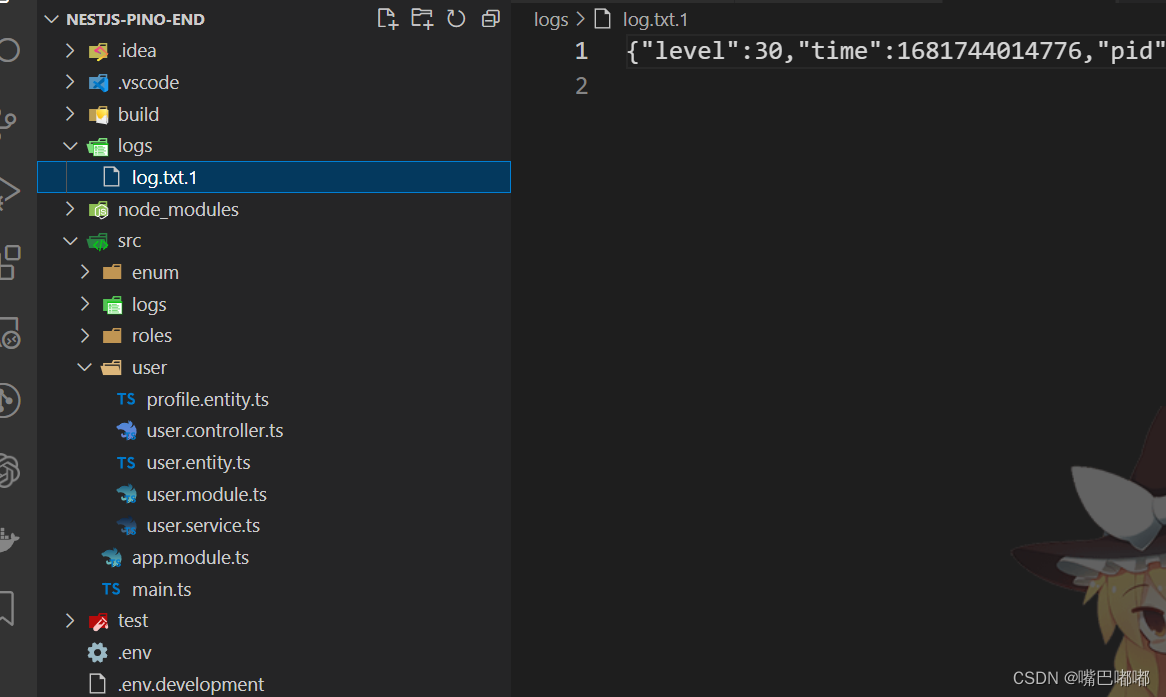
当然 我们也可以放在app.modules.ts中使用
import { Module } from '@nestjs/common';
import { UserModule } from './user/user.module';
import { ConfigModule, ConfigService } from '@nestjs/config';
import * as dotenv from 'dotenv';
import * as Joi from 'joi';
import { TypeOrmModule, TypeOrmModuleOptions } from '@nestjs/typeorm';
import { LoggerModule } from 'nestjs-pino';
import { join } from 'path';
import { ConfigEnum } from './enum/config.enum';
import { User } from './user/user.entity';
import { Profile } from './user/profile.entity';
import { Logs } from './logs/logs.entity';
import { Roles } from './roles/roles.entity';
const envFilePath = `.env.${process.env.NODE_ENV || `development`}`;
@Module({
imports: [
ConfigModule.forRoot({
isGlobal: true,
envFilePath,
load: [() => dotenv.config({ path: '.env' })],
validationSchema: Joi.object({
NODE_ENV: Joi.string()
.valid('development', 'production')
.default('development'),
DB_PORT: Joi.number().default(3306),
DB_HOST: Joi.string().ip(),
DB_TYPE: Joi.string().valid('mysql', 'postgres'),
DB_DATABASE: Joi.string().required(),
DB_USERNAME: Joi.string().required(),
DB_PASSWORD: Joi.string().required(),
DB_SYNC: Joi.boolean().default(false),
}),
}),
TypeOrmModule.forRootAsync({
imports: [ConfigModule],
inject: [ConfigService],
useFactory: (configService: ConfigService) =>
({
type: configService.get(ConfigEnum.DB_TYPE),
host: configService.get(ConfigEnum.DB_HOST),
port: configService.get(ConfigEnum.DB_PORT),
username: configService.get(ConfigEnum.DB_USERNAME),
password: configService.get(ConfigEnum.DB_PASSWORD),
database: configService.get(ConfigEnum.DB_DATABASE),
entities: [User, Profile, Logs, Roles],
// 同步本地的schema与数据库 -> 初始化的时候去使用
synchronize: configService.get(ConfigEnum.DB_SYNC),
// logging: process.env.NODE_ENV === 'development',
logging: false,
} as TypeOrmModuleOptions),
}),
LoggerModule.forRoot({
pinoHttp: {
transport: {
targets: [
process.env.NODE_ENV === 'development'
? {
level: 'info',
target: 'pino-pretty',
options: {
colorize: true,
},
}
: {
level: 'info',
target: 'pino-roll',
options: {
file: join('logs', 'log.txt'),
frequency: 'daily', // hourly
size: '10m',
mkdir: true,
},
},
],
},
UserModule,
],
controllers: [],
providers: [],
})
export class AppModule {}
winston
Winston 是强大、灵活的 Node.js 开源日志库之一,理论上, Winston 是一个可以记录所有信息的记录器。这是一个高度直观的工具,易于定制。可以通过更改几行代码来调整其背后的逻辑。它使对数据库或文件等持久存储位置的日志记录变得简单容易。
Winston 提供以下功能:
集中控制日志记录的方式和时间:在一个地方更改代码即可
控制日志发送的位置:将日志同步保存到多个目的地(如Elasticsearch、MongoDB、Postgres等)。
自定义日志格式:带有时间戳、颜色日志级别、JSON格式等前缀。
winston实践
这里我们使用的nestjs项目所以我们需要下载的是 nest-wnston 官方实例
npm install --save nest-winston winston
Replacing the Nest logger
该模块还提供了WinstonLogger类(LoggerService接口的自定义实现),供Nest用于系统日志记录。这将确保Nest系统日志和你的应用程序事件/消息日志的行为和格式的一致性。
来到我们的代码中main.ts
// import { Logger } from '@nestjs/common';
import { NestFactory } from '@nestjs/core';
import { createLogger } from 'winston';
import { AppModule } from './app.module';
import * as winston from 'winston';
async function bootstrap() {
// const logger = new Logger();
// createLogger of Winston
const instance = createLogger({
// options of Winston
transports: [
new winston.transports.Console({
level: 'info',
// 字符串拼接
format: winston.format.combine(
winston.format.timestamp(),
utilities.format.nestLike(),
),
}),
],
});
const app = await NestFactory.create(AppModule, {
// 关闭整个nestjs日志
// logger: false,
// logger: ['error', 'warn'],
// bufferLogs: true,
logger: WinstonModule.createLogger({
instance,
}),
});
app.setGlobalPrefix('api/v1');
const port = 3000;
await app.listen(port);
// logger.log(`App 运行在:${port}`);
// logger.warn(`App 运行在:${port}`);
// logger.error(`App 运行在:${port}`);
}
bootstrap();
在来到app.module.ts文件中
// 全局注册
@Global()
@Module({
// 依赖注入
providers: [Logger],
// 官方文档中没有这个,有可能在按照官方实例会报错,通过官方的issues 可以看到这个问题,根据官方实例即可获得答案
exports: [Logger],
})
export class AppModule {}
exports 使用导出 全局都可以使用
user.controll.ts 使用
import { Controller, Delete, Get, Patch, Post, Logger } from '@nestjs/common';
import { UserService } from './user.service';
import { ConfigService } from '@nestjs/config';
import { User } from './user.entity';
@Controller('user')
export class UserController {
// private logger = new Logger(UserController.name);
constructor(
private userService: UserService,
private configService: ConfigService,
private readonly logger: Logger,
) {
this.logger.log('UserController init');
}
@Get()
getUsers(): any {
this.logger.log(`请求getUsers成功`);
this.logger.warn(`请求getUsers成功`);
this.logger.error(`请求getUsers成功`);
return this.userService.findAll();
// return this.userService.getUsers();
}
@Post()
addUser(): any {
// todo 解析Body参数
const user = { username: 'toimc', password: '123456' } as User;
// return this.userService.addUser();
return this.userService.create(user);
}
@Patch()
updateUser(): any {
// todo 传递参数id
// todo 异常处理
const user = { username: 'newname' } as User;
return this.userService.update(1, user);
}
@Delete()
deleteUser(): any {
// todo 传递参数id
return this.userService.remove(1);
}
@Get('/profile')
getUserProfile(): any {
return this.userService.findProfile(2);
}
@Get('/logs')
getUserLogs(): any {
return this.userService.findUserLogs(2);
}
@Get('/logsByGroup')
async getLogsByGroup(): Promise<any> {
const res = await this.userService.findLogsByGroup(2);
// return res.map((o) => ({
// result: o.result,
// count: o.count,
// }));
return res;
}
}
打印结果:

滚动打印日志:
main.ts 中 使用import 'winston-daily-rotate-file';
// import { Logger } from '@nestjs/common';
import { NestFactory } from '@nestjs/core';
import { createLogger } from 'winston';
import { AppModule } from './app.module';
import * as winston from 'winston';
import { utilities, WinstonModule } from 'nest-winston';
import 'winston-daily-rotate-file';
async function bootstrap() {
// const logger = new Logger();
// createLogger of Winston
const instance = createLogger({
// options of Winston
transports: [
new winston.transports.Console({
level: 'info',
format: winston.format.combine(
winston.format.timestamp(),
utilities.format.nestLike(),
),
}),
// events - archive rotate
new winston.transports.DailyRotateFile({
level: 'warn',
dirname: 'logs',
filename: 'application-%DATE%.log',
datePattern: 'YYYY-MM-DD-HH',
zippedArchive: true,
maxSize: '20m',
maxFiles: '14d',
format: winston.format.combine(
winston.format.timestamp(),
winston.format.simple(),
),
}),
new winston.transports.DailyRotateFile({
level: 'info',
dirname: 'logs',
filename: 'info-%DATE%.log',
datePattern: 'YYYY-MM-DD-HH',
zippedArchive: true,
// 文件大小
maxSize: '20m',
// 最多14 天
maxFiles: '14d',
format: winston.format.combine(
winston.format.timestamp(),
winston.format.simple(),
),
}),
],
});
const app = await NestFactory.create(AppModule, {
// 关闭整个nestjs日志
// logger: false,
// logger: ['error', 'warn'],
// bufferLogs: true,
logger: WinstonModule.createLogger({
instance,
}),
});
app.setGlobalPrefix('api/v1');
const port = 3000;
await app.listen(port);
// logger.log(`App 运行在:${port}`);
// logger.warn(`App 运行在:${port}`);
// logger.error(`App 运行在:${port}`);
}
bootstrap();
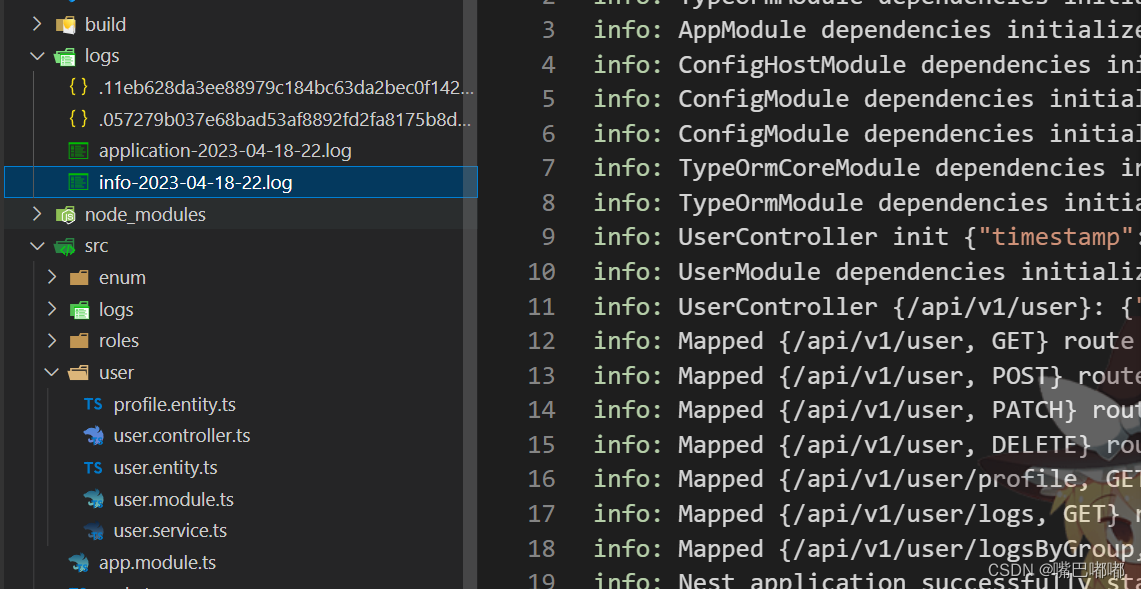
到这里我们就完成了 日志配置的三种方式:官方、 pion、winston,个人还是喜欢winston,这个还是根据项目来做决定。接下来是这篇文章的加餐课,如需要的了解更多的小伙伴可以多学习一下。
配置winston记录日志(全局异常过滤器)
场景:我们开发了很多接口,项目中我们会使用try…catch ,但是每个路由都加上的话会很麻烦,我们需要全局处理 try… catch… ,nestj 自带会帮我们处理。

postmen 测试一下,路由不存在的情况:
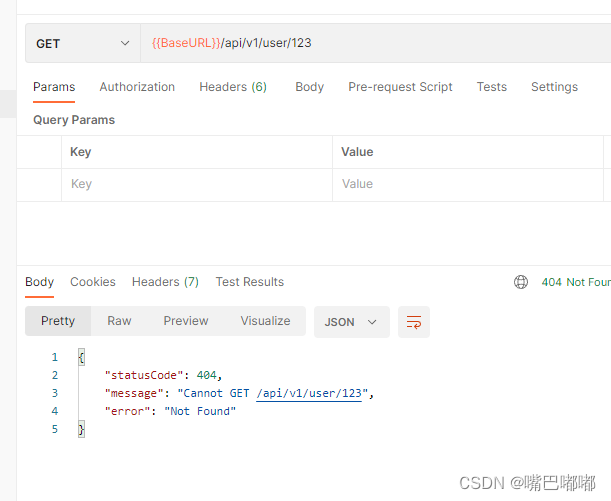
异常过滤器
内置的异常层负责处理整个应用程序中的所有抛出的异常。当捕获到未处理的异常时,最终用户将收到友好的响应。
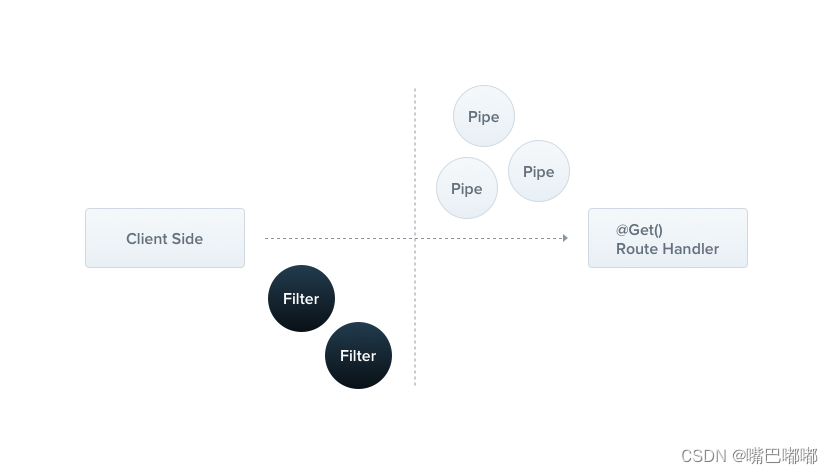
开箱即用,此操作由内置的全局异常过滤器执行,该过滤器处理类型 HttpException(及其子类)的异常。每个发生的异常都由全局异常过滤器处理, 当这个异常无法被识别时 (既不是 HttpException 也不是继承的类 HttpException ) , 用户将收到以下 JSON 响应:
{
"statusCode": 500,
"message": "Internal server error"
}
项目中使用:
app.control.ts
@Get()
getUsers(): any {
const user = { isAdmin: false };
if (!user.isAdmin) {
throw new HttpException('Forbidden', HttpStatus.FORBIDDEN);
}
return this.userService.findAll();
// return this.userService.getUsers();
}
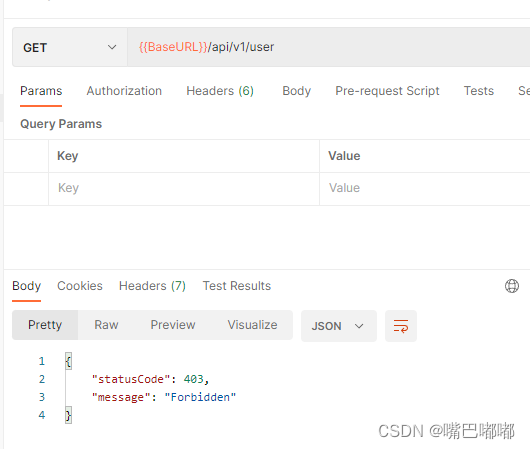
常见的状态码:
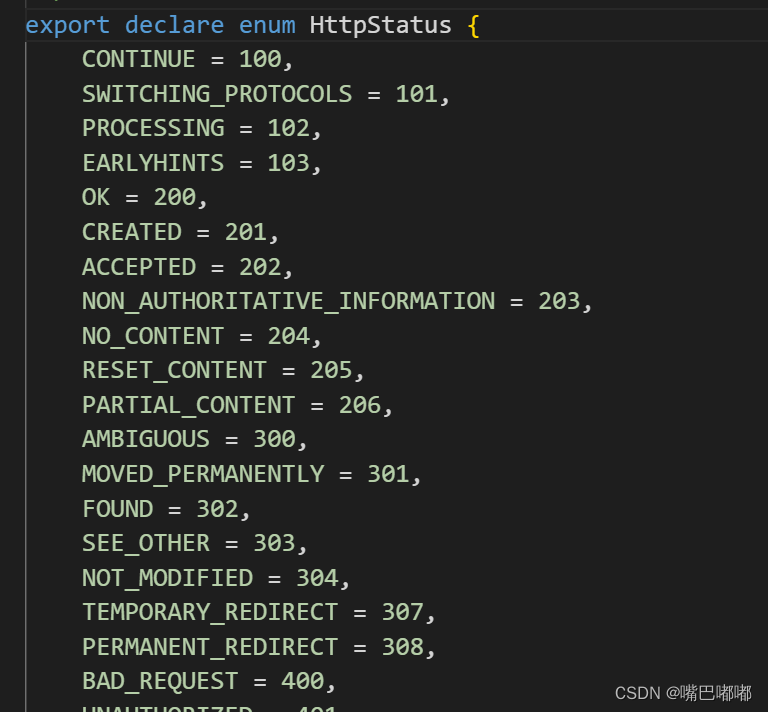
HttpException 构造函数有两个必要的参数来决定响应:
-
response 参数定义 JSON 响应体。它可以是 string 或 object,如下所述。
-
status参数定义HTTP状态代码。
默认情况下,JSON 响应主体包含两个属性:
-
statusCode:默认为 status 参数中提供的 HTTP 状态代码
-
message:基于状态的 HTTP 错误的简短描述
仅覆盖 JSON 响应主体的消息部分,请在 response参数中提供一个 string。
要覆盖整个 JSON 响应主体,请在response 参数中传递一个object。 Nest将序列化对象,并将其作为JSON 响应返回。
第二个构造函数参数-status-是有效的 HTTP 状态代码。 最佳实践是使用从@nestjs/common导入的 HttpStatus枚举。
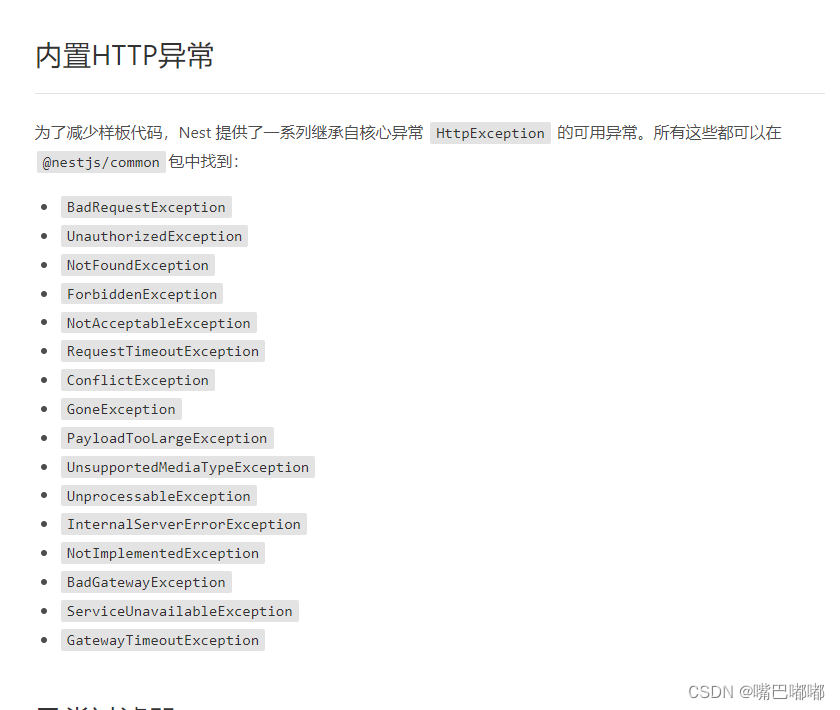
基础案列演示完毕,我们开始捕获全局http协议:
新建文件夹,src\filters\http-exception.filter.ts
import {
ArgumentsHost,
Catch,
ExceptionFilter,
HttpException,
} from '@nestjs/common';
@Catch(HttpException)
export class HttpExceptionFilter implements ExceptionFilter {
catch(exception: HttpException, host: ArgumentsHost) {
// 获取上下文
const ctx = host.switchToHttp();
// 响应和请求对象
const response = ctx.getResponse();
const request = ctx.getRequest();
const status = exception.getStatus();
response.status(status).json({
code: status,
timestamp: new Date().toISOString(),
path: request.url,
method: request.method,
});
}
}
应用过滤器
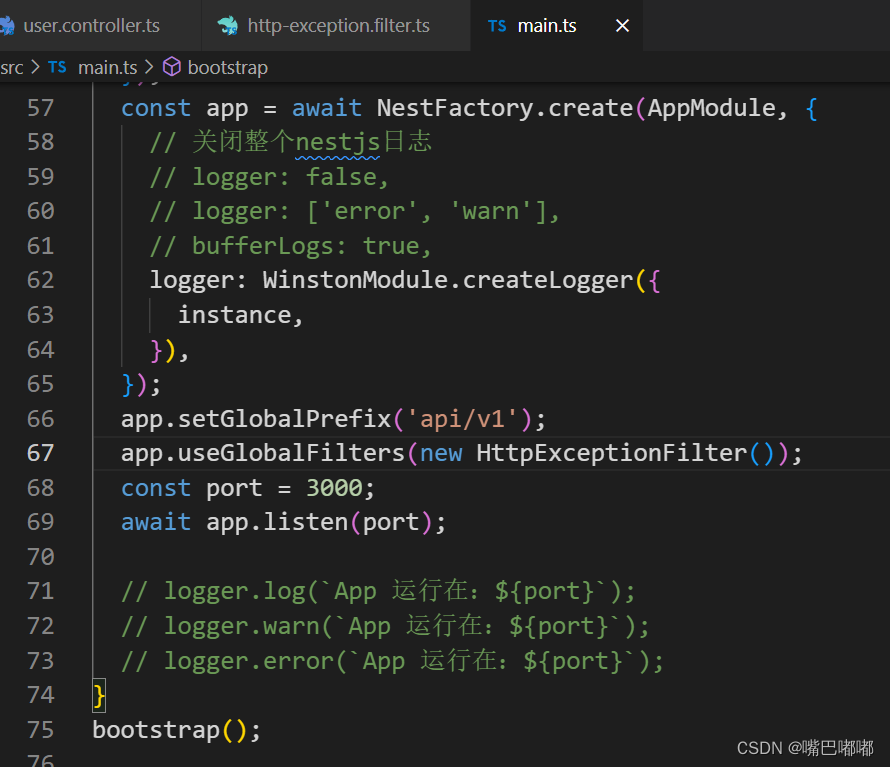
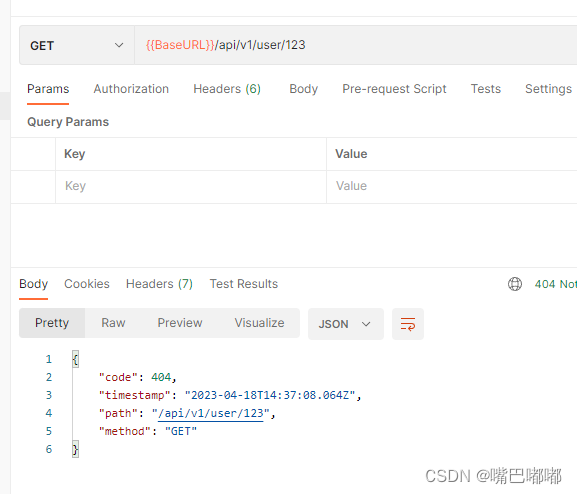
基本过滤器演示结束,我们还需要在因在日志中,需要对 filters文件夹进行改造:
import { LoggerService } from '@nestjs/common';
import {
ArgumentsHost,
Catch,
ExceptionFilter,
HttpException,
} from '@nestjs/common';
@Catch(HttpException)
export class HttpExceptionFilter implements ExceptionFilter {
constructor(private logger: LoggerService) {}
catch(exception: HttpException, host: ArgumentsHost) {
// 获取上下文
const ctx = host.switchToHttp();
// 响应和请求对象
const response = ctx.getResponse();
const request = ctx.getRequest();
const status = exception.getStatus();
this.logger.error(exception.message, exception.stack);
response.status(status).json({
code: status,
timestamp: new Date().toISOString(),
method: request.method,
message: exception.message || exception.name,
});
}
}
main.ts 改造:
// import { Logger } from '@nestjs/common';
import { NestFactory } from '@nestjs/core';
import { createLogger } from 'winston';
import { AppModule } from './app.module';
import * as winston from 'winston';
import { utilities, WinstonModule } from 'nest-winston';
import 'winston-daily-rotate-file';
import { HttpExceptionFilter } from './filters/http-exception.filter';
async function bootstrap() {
// const logger = new Logger();
// createLogger of Winston
const instance = createLogger({
// options of Winston
transports: [
new winston.transports.Console({
level: 'info',
format: winston.format.combine(
winston.format.timestamp(),
utilities.format.nestLike(),
),
}),
// events - archive rotate
new winston.transports.DailyRotateFile({
level: 'warn',
dirname: 'logs',
filename: 'application-%DATE%.log',
datePattern: 'YYYY-MM-DD-HH',
zippedArchive: true,
maxSize: '20m',
maxFiles: '14d',
format: winston.format.combine(
winston.format.timestamp(),
winston.format.simple(),
),
}),
new winston.transports.DailyRotateFile({
level: 'info',
dirname: 'logs',
filename: 'info-%DATE%.log',
datePattern: 'YYYY-MM-DD-HH',
zippedArchive: true,
maxSize: '20m',
maxFiles: '14d',
format: winston.format.combine(
winston.format.timestamp(),
winston.format.simple(),
),
}),
],
});
const logger = WinstonModule.createLogger({
instance,
});
const app = await NestFactory.create(AppModule, {
logger,
});
app.setGlobalPrefix('api/v1');
app.useGlobalFilters(new HttpExceptionFilter(logger));
const port = 3000;
await app.listen(port);
}
bootstrap();
拓展:全局所有异常捕获
import {
ExceptionFilter,
HttpAdapterHost,
HttpException,
HttpStatus,
LoggerService,
} from '@nestjs/common';
import { ArgumentsHost, Catch } from '@nestjs/common';
import * as requestIp from 'request-ip';
// 捕获所有异常
@Catch()
export class AllExceptionFilter implements ExceptionFilter {
constructor(
private readonly logger: LoggerService,
private readonly httpAdapterHost: HttpAdapterHost,
) {}
catch(exception: unknown, host: ArgumentsHost) {
const { httpAdapter } = this.httpAdapterHost;
const ctx = host.switchToHttp();
const request = ctx.getRequest();
const response = ctx.getResponse();
const httpStatus =
exception instanceof HttpException
? exception.getStatus()
: HttpStatus.INTERNAL_SERVER_ERROR;
const responseBody = {
headers: request.headers,
query: request.query,
body: request.body,
params: request.params,
timestamp: new Date().toISOString(),
// 还可以加入一些用户信息
// IP信息
ip: requestIp.getClientIp(request),
exceptioin: exception['name'],
error: exception['response'] || 'Internal Server Error',
};
this.logger.error('[toimc]', responseBody);
httpAdapter.reply(response, responseBody, httpStatus);
}
}
main.ts
const httpAdapter = app.get(HttpAdapterHost);
app.useGlobalFilters(new AllExceptionFilter(logger, httpAdapter));
ok,这是一篇长篇文章,能看到的结束的小伙伴也是很厉害的。我也是要写吐了
写着写着就多了,可能太想和大家分享知识了。 已经学明白的同学可以 看我的下一篇文章 【NestJs】日志模块重构 这篇文章纯代码,然后使用了 开发规范创建的日志模块。

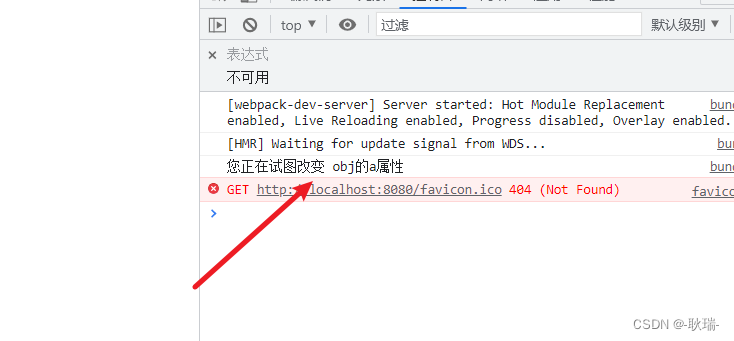

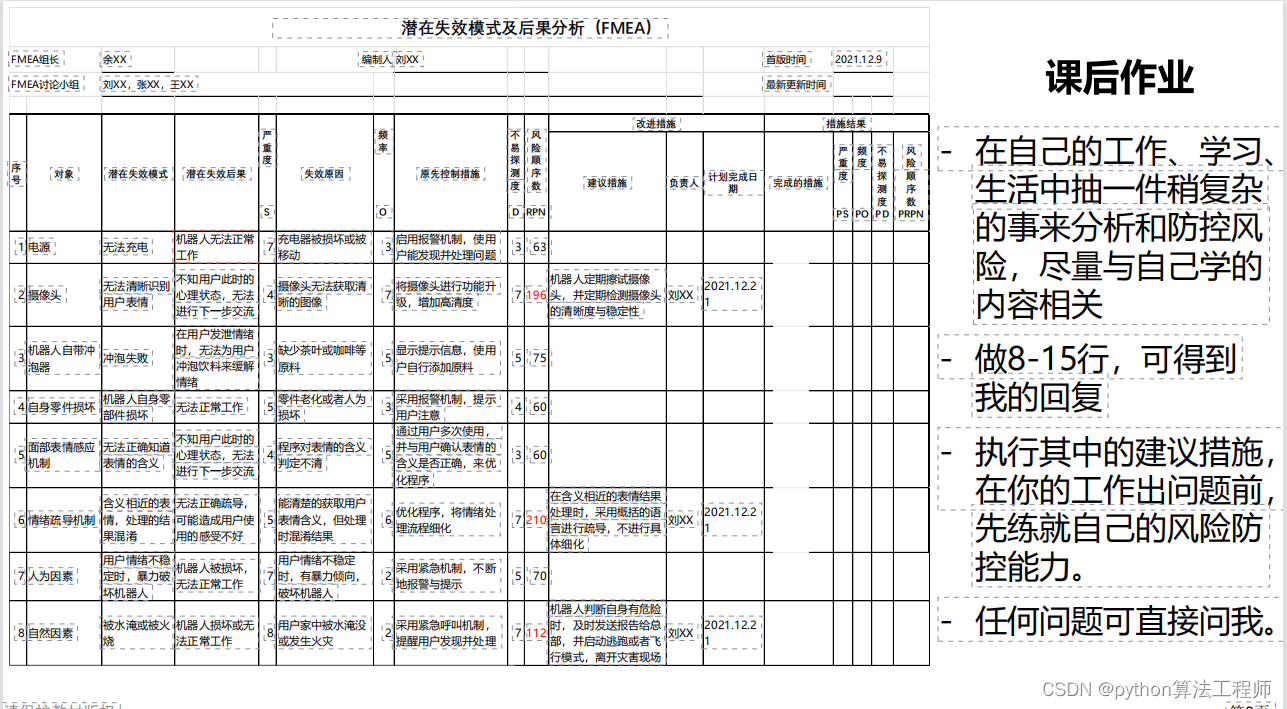

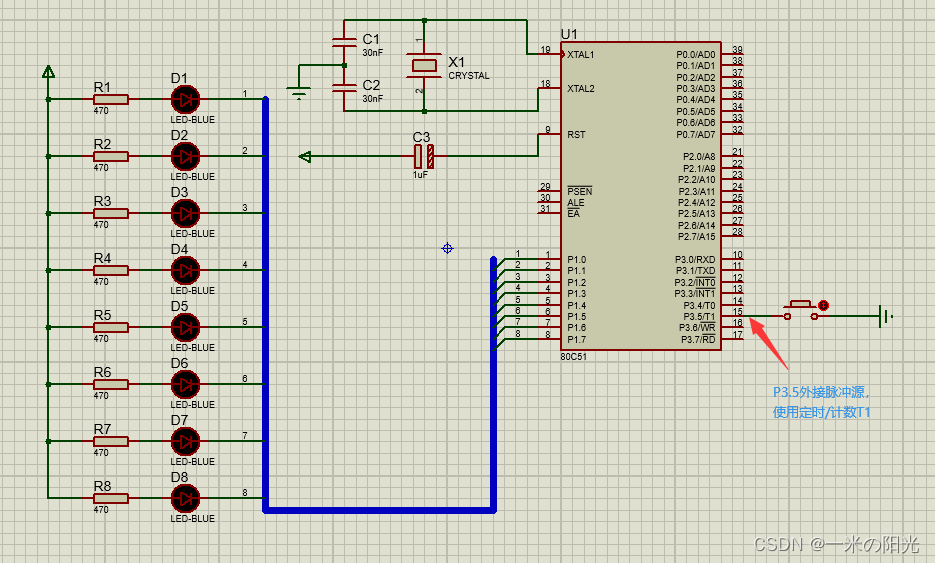


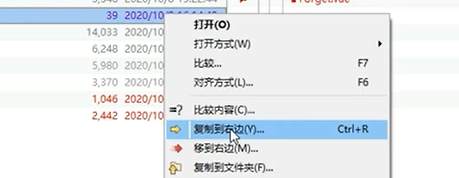



![[NOIP1999 普及组] Cantor 表](https://img-blog.csdnimg.cn/2b6f01e012f2409ea18a7505f214950c.png)
